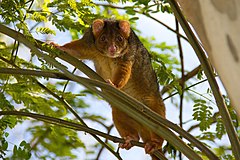Pseudopałanka
| Pseudocheirus | |||
| Ogilby, 1837[1] | |||
 Przedstawiciel rodzaju – pseudopałanka wędrowna (P. peregrinus) | |||
| Systematyka | |||
| Domena | |||
|---|---|---|---|
| Królestwo | |||
| Typ | |||
| Podtyp | |||
| Gromada | |||
| Podgromada | |||
| Rząd | |||
| Podrząd | |||
| Nadrodzina | |||
| Rodzina | |||
| Podrodzina | |||
| Rodzaj |
pseudopałanka | ||
| Typ nomenklatoryczny | |||
|
Phalangista cookii Desmarest, 1818 (= Didelphis peregrinus Boddaert, 1785) | |||
| Synonimy | |||
|
| |||
| Gatunki | |||
| |||
Pseudopałanka[5] (Pseudocheirus) – rodzaj ssaka z podrodziny pseudopałanek (Pseudocheirinae) w obrębie rodziny pseudopałankowatych (Pseudocheiridae).
Zasięg występowania[edytuj | edytuj kod]
Rodzaj obejmuje gatunki występujące w Australii (włącznie z Tasmanią)[6][7][8].
Morfologia[edytuj | edytuj kod]
Długość ciała 29–40 cm, długość ogona 29–41 cm; masa ciała 0,7–1,3 kg[6][9].
Systematyka[edytuj | edytuj kod]
Rodzaj zdefiniował w 1837 roku irlandzki przyrodnik William Ogilby na łamach Magazine of Natural History and journal of Zoology, Botany, Mineralogy, Geology and Meteorology[1]. Ogilby wymienił dwa gatunki nie wskazując gatunku typowego; w ramach późniejszego oznaczenia w 1945 roku angielsko-amerykański zoolog i botanik George Henry Hamilton Tate na typ nomenklatoryczny wyznaczył pseudopałankę wędrowną (P. peregrinus)[10].
Etymologia[edytuj | edytuj kod]
- Pseudocheirus (Pseudochirus): gr. ψευδος pseudos „fałszywy”; χειρ kheir, χειρος kheiros „dłoń”[11].
- Hepoona: Hepoona Boo tubylcza nazwa użyta przez Johna White’a w 1790 roku[12]. Gatunek typowy: Phalangista cookii Desmarest, 1818 (= Didelphis peregrinus Boddaert, 1785).
- Ptenos: gr. πτην ptēn, πτηνος ptēnos „skrzydlaty”, od πετομαι petomai „latać”[13].
Podział systematyczny[edytuj | edytuj kod]
Do rodzaju należą następujące występujące współcześnie gatunki[14][7][5]:
- Pseudocheirus occidentalis O. Thomas, 1888 – pseudopałanka zachodnia
- Pseudocheirus peregrinus (Boddaert, 1785) – pseudopałanka wędrowna
Opisano również gatunek wymarły z pliocenu Australii[15]:
- Pseudocheirus marshalli Turnbull & Lundelius, 1970
Uwagi[edytuj | edytuj kod]
- ↑ a b Nomen nudum.
Przypisy[edytuj | edytuj kod]
- ↑ a b W. Ogilby. Observations on the opposable Power of the Thumb in certain Mammals, considered as a zoological Character; and on the natural Affinities which subsist between the Pedimana. „Magazine of Natural History and journal of Zoology, Botany, Mineralogy, Geology and Meteorology”. New Series. 1, s. 457, 1837. (ang.).
- ↑ W. Ogilby. Observations upon the opposable power of the thumb in certain Mammals, considered as a zoological character, and on the natural affinities which subsist between the Bimana, Quadrumana, and Pedimana. „Proceedings of the Zoological Society of London”. 4, s. 26, 1836. (ang.).
- ↑ W. Ogilby. Observations upon some recent Communications of Mr. J. E. Gray of the British Museum, to the Annals of Natural History; with Descriptions of two New Kangaroos from Van Diemen’s Land. „Annals of Natural History”. 1, s. 218, 219, 1841. (ang.).
- ↑ J.E. Gray: List of the specimens of Mammalia in the collection of the British museum. London: The Trustees, 1843, s. xxii. (ang.).
- ↑ a b Nazwy polskie za: W. Cichocki, A. Ważna, J. Cichocki, E. Rajska-Jurgiel, A. Jasiński & W. Bogdanowicz: Polskie nazewnictwo ssaków świata. Warszawa: Muzeum i Instytut Zoologii PAN, 2015, s. 13. ISBN 978-83-88147-15-9. (pol. • ang.).
- ↑ a b S. Jackson: Family Pseudocheiridae (Ring-tailed Possums and Greater Gliders). W: D.E. Wilson & R.A. Mittermeier: Handbook of the Mammals of the World. Cz. 5: Monotremes and Marsupials. Barcelona: Lynx Edicions, 2015, s. 527. ISBN 978-84-96553-99-6. (ang.).
- ↑ a b C.J. Burgin, D.E. Wilson, R.A. Mittermeier, A.B. Rylands, T.E. Lacher & W. Sechrest: Illustrated Checklist of the Mammals of the World. Cz. 1: Monotremata to Rodentia. Barcelona: Lynx Edicions, 2020, s. 86. ISBN 978-84-16728-34-3. (ang.).
- ↑ D.E. Wilson & D.M. Reeder (redaktorzy): Genus Pseudocheirus. [w:] Mammal Species of the World. A Taxonomic and Geographic Reference (Wyd. 3) [on-line]. Johns Hopkins University Press, 2005. [dostęp 2020-10-26].
- ↑ Class Mammalia. W: Lynx Nature Books (A. Monadjem (przedmowa) & C.J. Burgin (wstęp)): All the Mammals of the World. Barcelona: Lynx Edicions, 2023, s. 58. ISBN 978-84-16728-66-4. (ang.).
- ↑ G.H.H. Tate. The marsupial genus Pseudocheirus and its subgenera. „American Museum Novitates”. 1287, s. 6, 1945. (ang.).
- ↑ Palmer 1904 ↓, s. 590.
- ↑ Palmer 1904 ↓, s. 320.
- ↑ Palmer 1904 ↓, s. 594.
- ↑ N. Upham, C. Burgin, J. Widness, M. Becker, C. Parker, S. Liphardt, I. Rochon & D. Huckaby: Treeview of Mammalian Taxonomy Hierarchy. [w:] ASM Mammal Diversity Database (Version 1.11) [on-line]. American Society of Mammalogists. [dostęp 2023-08-05]. (ang.).
- ↑ W.D. Turnbull & E.L. Lundelius, Jr.. The Hamilton Fauna. A Late Pliocene mamalian fauna from the Grange Burn, Victoria, Australia. „Fieldiana”. Geology. 19, s. 40, 1970. (ang.).
Bibliografia[edytuj | edytuj kod]
- T.S. Palmer. Index Generum Mammalium: a List of the Genera and Families of Mammals. „North American Fauna”. 23, s. 1–984, 1904. (ang.).
